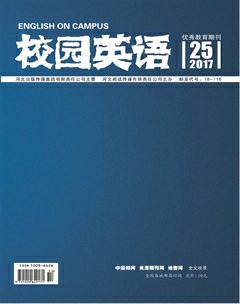The Mechanism of Translating Chinese Classics
【Abstract】Currently, our nation adopts the “going out” strategy, in which the translation of Chinese classics plays an important part. However, for a long time, people in the translation circle dampened translation with “untranslatability”, mostly from the cultural perspective. Zhao Yanchun, however, doubts “untranslability”, holding that translation, especially translation of Chinese classics, is possible if we grasp its nature and mechanism. And this paper shares his point of view.
【Key words】translation of Chinese classics; principles; mechanism
1. Introduction
At present, the strategy of Chinese culture going out has gained due attention from our government. And Chinese classics is a constitutive part of Chinese culture. So spreading out our classics to the world can contribute a lot to the success of the strategy. Seen from this perspective, the proper translation of Chinese classics becomes of great essence. Concerning this issue, many translators have proposed their views. However, they rarely centre on the central issues of translatology. Thus, it is necessary a feasible theory be carried out to cope with the issues in translating Chinese classics.
2. The nature of translation and its mechanism
Many scholars have talked about the nature of translation. Generally speaking, translation is the representation of the source information in the target language. According to Gutt (1991), this process is relevance-based. That is to say, cohering to the relevance theory(Sperber & Wilson, 2008), an ostensive-inferential process is conducted on the original work. Realizing that this process is dynamic, Zhao(2005)gives a more exact and reasonable definition: translation is not a static encoding-decoding practice. Instead, it takes relevance as the criterion, the adaptation as the method, the intention as the goal, thus being a dynamic process aiming to make the translation as convergent as possible to the source text. In a word, translation is a dynamic communicative behavior and it involves many variables and parameters. Having these in mind, we are intended to explore the communicative intention and pay attention to various parameters, especially those of structure and meaning. Being part of translation, the translation of Chinese classics definitely should comply with the above principles. Take the translation of三字經(Three Word Primer)as an example, every clause is composed of three characters rhyme at the last syllable.endprint
According to Zhao(2005), it is a dialectical one in which every factor counterbalances each other. As mentioned above, this mechanism includes principles and parameters. Principles, like those of relevance and convergence, should be firmly and strictly cohered to. They decide how we balance the importance of form and meaning in translation, with the latter entailing the ideological contents and cultural connotations. To be objective, for the parameters of the principles, there is somewhat flexibility. That is to say, parameters can be modulated by weighting advantages and disadvantages. Even more importantly, we should accurately balance the form and the meaning. But we have to accept that English is so much different from Chinese in many aspects. In consequence we may suspect the possibility of presenting the translation as equivalent as the original. Zhao proposes the solution: analogy is the basic technique in translating and it also acts as the cornerstone in the translation of Chinese classics. Analogy is a process of transferring information or meaning from a particular subject (the analogue or source) to another particular subject (the target), or a linguistic expression corresponding to such a process. Specifically speaking, in translation, analogy is to resolve the contradictions stirred by the differences between source language and target language via manipulating language in the target context in a similar way. This process of analogizing is open, constrained by the principle of relevance and convergence.
However, analogy is not a simple skill or strategy which we may get used to. Instead, it is the basic law of translation. And it belongs to the category of the essential attributes of translation. Because of the uniqueness of Chinese classics, the methodology of analogy becomes more salient. And it turns to be the foundation for us consciously when translating the classic works.
3. Conclusion
Since the translation of Chinese classics is an important constitutive part of the strategy of our culture going out, the successful output of them can strengthen our cultural influence. Thus it becomes necessary that we be clear of the nature of translation and its working mechanism.
References:
[1]Deirdre,W.,&Dan,S.Relevance Theory.The Handbook of Pragmatics.Blackwell Publishing Ltd.,2008.
[2]Gutt,Ersnst-August.Translation and Relevance[M].Cognition and Context.Oxford:Basil,1991.
[3]趙彦春.翻译学归结论[M].上海:上海外语教育出版社,2005.
作者简介:汪更新(1991.07-),女,汉族,河南驻马店人,硕士,就读于天津外国语大学,研究专业英语语言文学。endprint

